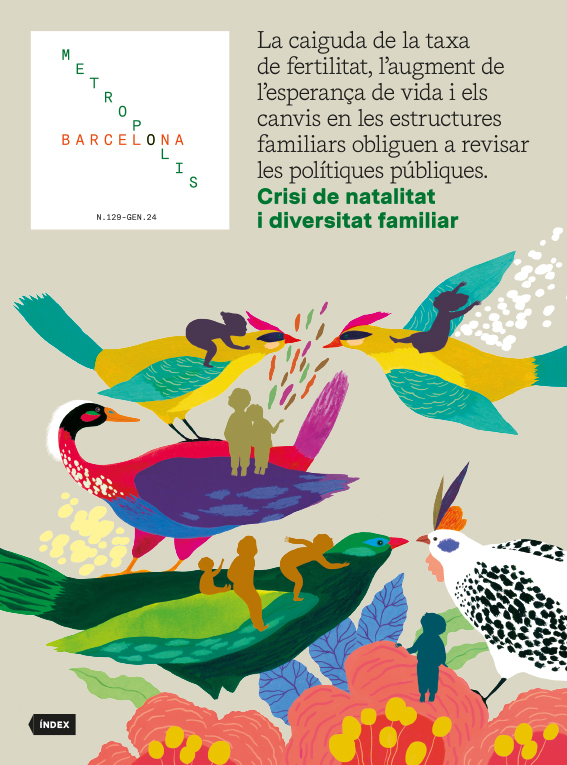What are the people of Barcelona like, how do they live and what do they think?
- Open data
- Jan 24
- 4 mins

Oriol Pàmies, texts / Carles Javierre Kohan, infographics
Barcelona is experiencing growth (1.3% in the last year), driven by immigration (31% of registered residents born abroad, representing 177 nationalities), and its inhabitants are increasingly choosing to live alone (almost one third of households are single-person). These figures emerge from the municipal register of January 2023, complemented on the following pages by a high-quality demoscopic source: the Municipal Services Survey – available only in Catalan (Enquesta de Serveis Municipals) – based on 6,000 interviews with adults. This survey sheds light on the ideology, religious beliefs, media habits and other characteristics of the people of Barcelona.
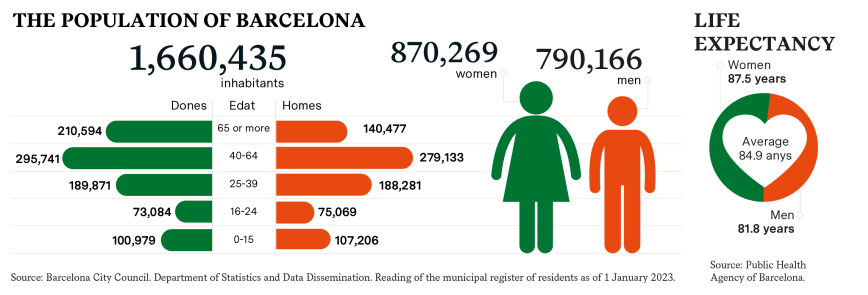
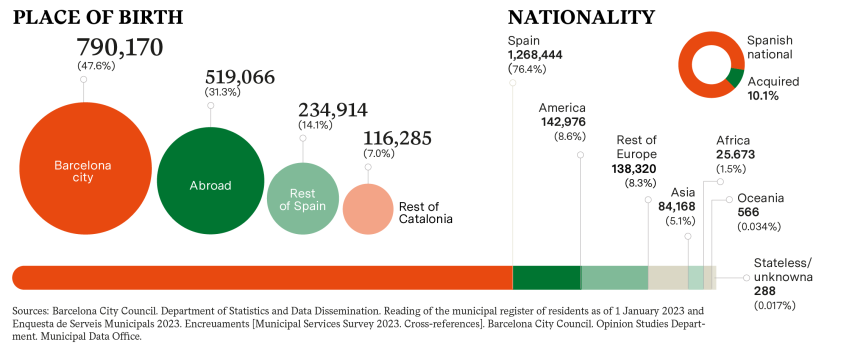
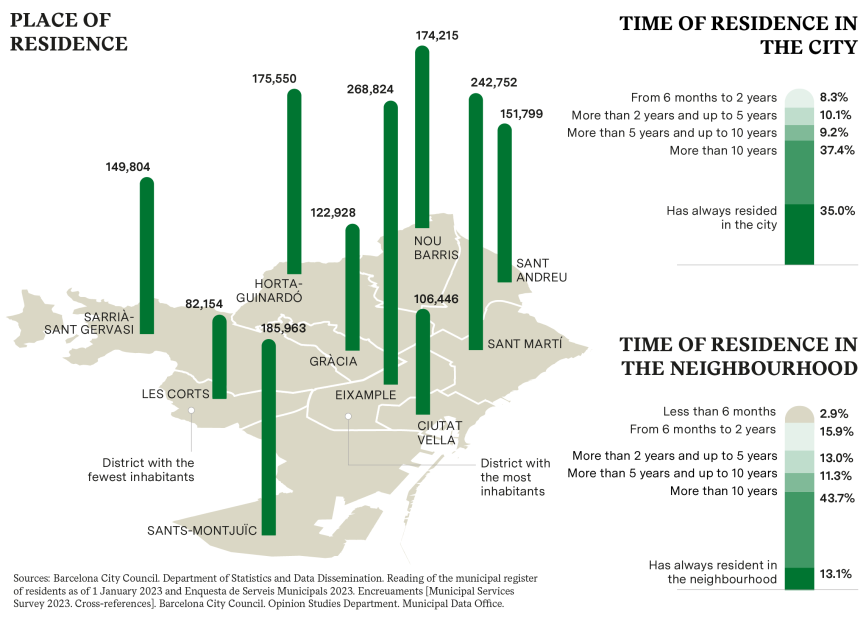
Smallest household units
Out of the 213,839 single-person households, 60.9% are occupied by women, while the remaining 39.1% are occupied by men. The proportion of two-person households, once the majority in past decades, has now dropped to below 30%. Noteworthy is residents’ loyalty to the city: 72.4% of adults have lived there for at least 10 years, and 56.8% haven’t changed neighbourhoods in the same period. The housing ownership landscape is also stable, with ownership slightly outweighing renting. Over a quarter of property owners do not fully own their homes due to outstanding mortgages.
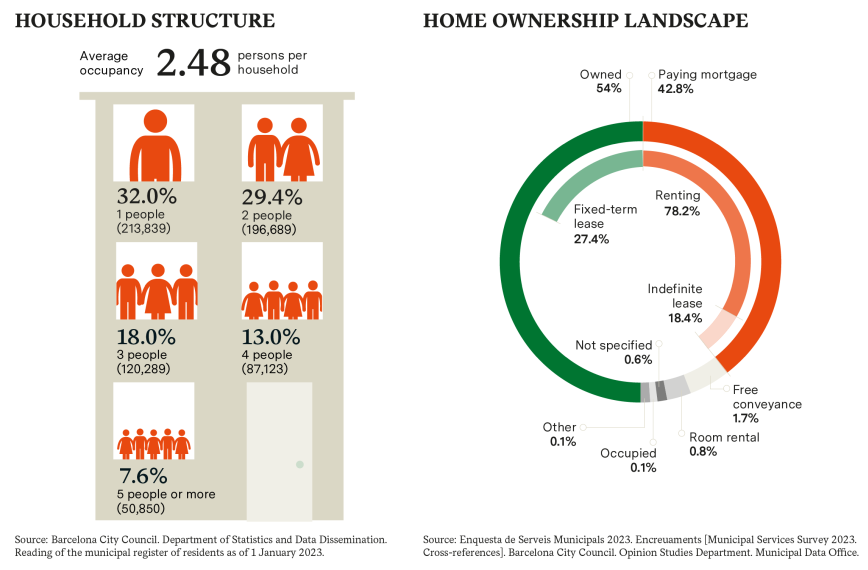
More pensioners, less domestic labour
Salaried employment for third party employers is the most common primary employment status among adults, with retirement or pensioner status also on the rise. Approximately one in ten individuals identifies as self-employed, with or without hired staff. Notably, there has been a significant shift over the last thirty decades, with the percentage of individuals engaged in unpaid domestic labour dropping from 29.3% to 4.1%.
![EMPLOYMENT STATUS. Source: Enquesta de Serveis Municipals 2023. Encreuaments [Municipal Services Survey 2023. Cross-references]. Barcelona City Council. Opinion Studies Department. Municipal Data Office.](https://www.barcelona.cat/metropolis/sites/default/files/styles/img_central/public/bcnm129_eng_web_05.png?itok=hq8BCW5a)
Educational attainment and income
The educational attainment of the population is on the rise. In over half of households, the primary income earner has completed university or postgraduate education. Additionally, the average declared net income per family is increasing, having doubled over the past two decades.
![EDUCATIONAL ATTAINMENT OF HOUSEHOLD’S PRIMARY INCOME EARNER / NET MONTHLY INCOME PER FAMILY (€). Source: Enquesta de Serveis Municipals 2023. Encreuaments [Municipal Services Survey 2023. Cross-references]. Barcelona City Council. Municipal Data Office.](https://www.barcelona.cat/metropolis/sites/default/files/styles/img_central/public/bcnm129_eng_web-06.png?itok=OU1mg47W)
Catalan on the decline
Over the past three decades, half of Barcelona’s adults have predominantly spoken Spanish. The percentage of individuals regarding Catalan as their first language, once comparable, has steadily declined, reaching a minimum of 36.5%. Simultaneously, the category of “other languages” has emerged, constituting 7.4%. As for Catalan, proficiency levels remain notably high: 93.9% understand it, 74.7% can speak it, and 61.7% can write in Catalan.
![PRIMARY LANGUAGE. Source: Enquesta de Serveis Municipals 2023 [Municipal Services Survey 2023]. Barcelona City Council. Opinion Studies Department. Municipal Data Office.](https://www.barcelona.cat/metropolis/sites/default/files/styles/img_central/public/bcnm129_eng_web-07.png?itok=C2WmouAC)
Towards the left
Ideologically, most of Barcelona’s population leans predominantly towards the left and centre left. They identify themselves as both Catalan and Spanish, with some expressing a stronger connection to Catalan identity than Spanish. Additionally, a significant portion declares themselves as non-religious or agnostic.
![IDEOLOGY AND SENSE OF IDENTITY. Source: Enquesta de Serveis Municipals 2023 [Municipal Services Survey 2023]. Barcelona City Council. Opinion Studies Department. Municipal Data Office.](https://www.barcelona.cat/metropolis/sites/default/files/styles/img_central/public/bcnm129_eng_web-08.png?itok=97CX21xF)
![RELIGIOUS PRACTICE. Source: Enquesta de Serveis Municipals 2023 [Municipal Services Survey 2023]. Barcelona City Council. Opinion Studies Department. Municipal Data Office.](https://www.barcelona.cat/metropolis/sites/default/files/styles/img_central/public/bcnm129_eng_web-09.png?itok=BBQny5mn)
Retiring vehicles
Private cars are becoming increasingly expensive to maintain and less necessary in a city with short distances conducive to walking and an extensive public transportation network. Over the last two decades, the percentage of households owning at least one car has fallen by 11.5 points.
![VEHICLES PER HOUSEHOLD. Source: Enquesta de Serveis Municipals 2023 [Municipal Services Survey 2023]. Barcelona City Council. Opinion Studies Department. Municipal Data Office (people database).](https://www.barcelona.cat/metropolis/sites/default/files/styles/img_central/public/bcnm129_eng_web-10.png?itok=GavIbDMh)
Online presence at home and on mobile services
Wireless internet access at home has become nearly as widespread as mobile phone ownership (reaching 99.7% of the Barcelona population aged 18 to 74). It is not surprising that digital press and social media, with WhatsApp at the forefront, are gaining ground as the primary sources of information, gradually displacing television.
![HOME CONNECTIVITY. Source: Enquesta de Serveis Municipals 2023 [Municipal Services Survey 2023]. Barcelona City Council. Opinion Studies Department. Municipal Data Office.](https://www.barcelona.cat/metropolis/sites/default/files/styles/img_central/public/bcnm129_eng_web-11.png?itok=_awG7gVy)
![SOCIAL MEDIA PARTICIPATION / RANKED PERSONAL CONCERNS IN ORDER OF PERCEIVED SEVERITY. Source: Enquesta de Serveis Municipals 2023 [Municipal Services Survey 2023]. Barcelona City Council. Opinion Studies Department. Municipal Data Office.](https://www.barcelona.cat/metropolis/sites/default/files/styles/img_central/public/bcnm129_eng_web-12.png?itok=6jJxj7FF)
Rising prices: a noticeable trend
Over the last two years, personal finances have emerged as the most pressing concern, closely tied to the cost-of-living crisis triggered by the invasion of Ukraine. Simultaneously, worries about unemployment and working conditions have dwindled, mirroring employment trends. Insecurity and housing access, ranking 2nd and 4th, respectively, have become prominent issues in public discourse, in contrast to their limited impact a decade ago.
![RANKED PERSONAL CONCERNS IN ORDER OF PERCEIVED SEVERITY. Source: Enquesta de Serveis Municipals 2023 [Municipal Services Survey 2023]. Barcelona City Council. Opinion Studies Department. Municipal Data Office.](https://www.barcelona.cat/metropolis/sites/default/files/styles/img_central/public/bcnm129_eng_web-13.png?itok=8KAT2_Qm)
Content with city living
Satisfaction with living in Barcelona has consistently scored above 7 with minor fluctuations. Within the average favourable rating, the Nou Barris neighbourhood shows the highest satisfaction levels, while residents of Sarrià-Sant Gervasi are the least content.
![SATISFACTION WITH LIVING IN BARCELONA. Source: Enquesta de Serveis Municipals 2023 [Municipal Services Survey 2023]. Barcelona City Council. Opinion Studies Department. Municipal Data Office.](https://www.barcelona.cat/metropolis/sites/default/files/styles/img_central/public/bcnm129_eng_web-14.png?itok=tENXDd0c)
The newsletter
Subscribe to our newsletter to keep up to date with Barcelona Metròpolis' new developments




